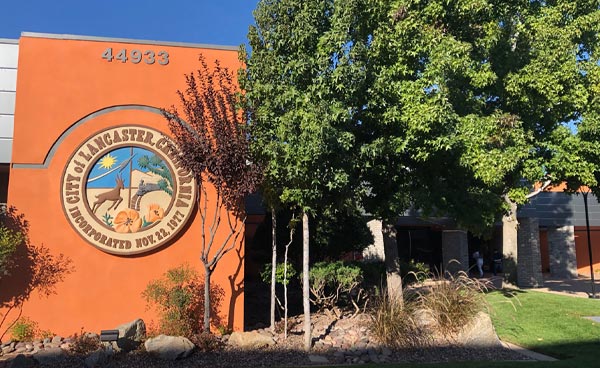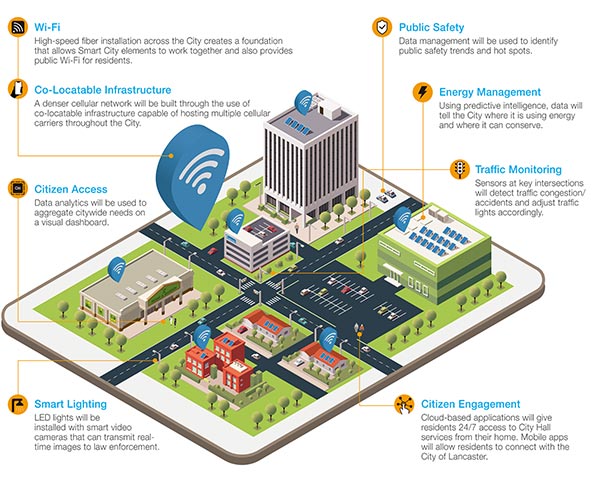
Lancaster is a charter city in northern Los Angeles County with a growing population of over 172,660. The city has been taking significant steps to leverage smart technologies to improve the lives of their citizens.
In accordance with the city’s vision of Strategic Technology, Innovation, and Resilience (STIR), the City of Lancaster launched a number of projects and initiatives towards becoming a Smart City, and continues to implement changes that advance accessibility, engagement, infrastructure, safety, and sustainability.

These Smart City implementations range from data-driven energy conservation and management to citizen engagement platforms. One of these is the Inform Lancaster app, which allows residents to use their mobile device to easily access information and report issues.
Another is the use of video cameras on LED street lights to help law enforcement improve public safety. These implementation projects also involve building a new Advanced Traffic Management System (ATMS) solution that uses smart devices to help cities work smarter to detect and report traffic conditions back to the remote Traffic Management Center (TMC).
This provides the city with real-time data and predictive intelligence to improve operations, such as management of signalized intersections and allowing traffic operators to adapt to traffic incidents and congestion.
Upgrading Aging Infrastructure
In order to achieve all of this, upgrading to high-speed fiber optic communications was required to serve as the foundation for these Smart City implementations.
A major component of the fiber upgrade was to migrate the existing copper traffic network to fiber in order to transform the traffic signal communication infrastructure from analog to digital, enhancing connectivity and transparency. With aging 30-year-old analog copper wiring and sparsely deployed fiber, over half of the city’s 140+ traffic signals were either offline or had no active communication with the traffic management system.
Mitch Megas, Traffic Engineering Technician, noted that: “With the legacy infrastructure, the communications would go down 10-15 times per week. And when exposed to harsh weather such as high temperatures or heavy rain, communication would go down completely.”
This meant that city administration frequently needed to dispatch technicians to check on equipment, sometimes in the middle of the night, taking up a lot of time and resources. Furthermore, the aging infrastructure did not allow for remote monitoring of traffic conditions, making it impossible to promptly react to traffic incidents or large traffic jams as they occurred.
Connecting the City
The City of Lancaster consulted with engineering design firm ADVANTEC Consulting Engineers Inc. to provide ITS services that included the design of a citywide traffic network and implementation of a modern ATMS. A total of 146 traffic cabinets needed to be connected to the fiber network and ATMS, so all traffic cabinets and remote assets could be managed from one central location. Since the entire system was designed from the ground up, a technology supplier with reliable, sustainable products and ample experience was needed. ADVANTEC Consulting Engineers Inc. selected Moxa. Moxa’s product performance, long-term value, and local support made them stand out during the evaluation process.
“We were happy to select Moxa hardware and monitoring software based on their extensive offering of full-Gigabit hardened edge switches, 24-port aggregation switches, and full Layer 3 core switch technologies. These hardened-grade products are perfect for ITS deployments and bring value to the City of Lancaster’s advanced traffic management network,” said John Cox, Systems Engineer of ADVANTEC Consulting Engineers.
With a Moxa hardware and software solution, the city could now take full advantage of many modern Intelligent Transportation System (ITS) technologies, such as high-definition surveillance cameras and Advanced Transportation Controller units. By creating a centralized operations center, staff can monitor and make changes to the system in real time.
The Moxa hardware solution brought full Gigabit speed all the way out to the edge —reaching every cabinet connected to the fiber infrastructure — future-proofing the network and providing the bandwidth necessary to support the data and video needs of today and tomorrow.
Reliably transferring large amounts of video, voice, and data
Moxa high-performance EDS-Series, IKS-Series, and ICS-Series switches connect the fiber network, capable of quickly and reliably transferring large amounts of video, voice, and data across the network. The core switch’s two 10G uplink capabilities also provide future expansion possibilities for the city. As the City of Lancaster implements more CCTV applications alongside the expected increase of connected and automated vehicles,
more devices will need to be connected to the network, adding to the total amount of data that is processed over the network. Having a high-speed fiber optic communications network ensures they are ready to handle any increase of device connections in the future.
“Since installing the Moxa switches, the only thing that would take them offline would be the cabinet being hit in a traffic accident and causing the fiber to become disconnected. One of our cabinets was energized with high voltage from an Edison line, and the only component in the cabinet that was still functioning was the Moxa switch,” explained Mitch Megas, Traffic Engineering Technician for the City of Lancaster
Easing Network Management Burdens
Moxa’s industrial network management software, MXview, makes it possible for staff to configure, monitor, and diagnose the network from one central location. A custom dashboard enhances transparency and efficiency while reducing the need for time-consuming manual configuration. In addition, MXview allows monitoring staff to overlay the network topology on top of a geographic map of the city to create accurate visual geographical representations of all deployed equipment.
“Moxa MXview comes in very handy for my team to manage the traffic network. It can be accessed through any web browser. We can upload the city map to view where Moxa networking devices are located and identify bottlenecks, making it easier to set network traffic thresholds,” said Mitch Megas Traffic Engineering Technician for the City of Lancaster.
As more and more devices are required to be connected to the network, security of the traffic communication system becomes a concern. Moxa’s MXview enables city staff to conduct a network security audit with a simple click of a mouse, allowing them to manage remote device security from the central control room.
For instance, if a device fails the security policy audit, MXview can remotely update the device’s configuration or send out security alert notifications whenever it detects an authentication failure. In summary, Moxa’s edge-to-core solution enables smart cities to create a traffic network infrastructure that is future-ready, highly reliable, secure down to the device level, and easy to manage with smart, intuitive management tools
Source: moxa.com
